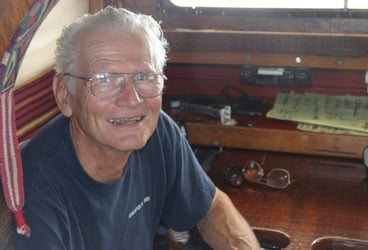
HWSept368
The sailing season is relatively short here in Newport, Rhode Island, but in the six months or so when things are really hopping it’s an embarrassment of riches. On any given summer’s day, even on the briefest of daysails, the breadth and variety of boats you might encounter is amazing: former America’s Cup winners, famous racing yachts both past and present, classic beauties, round-the-world record setters, and of course every size and stripe of cruising boat imaginable.
Late last month, the harbor was graced by one of the funkier– and yet cooler– sailboats to roll into town in quite some time. But yacht designer and builder Jim Brown’s home-built, plywood, Searunner 31 trimaran, Scrimshaw, in its own way is every bit as important and impressive as anything afloat. A lot of boats have won races or taken sailors to faraway destinations, but not many can be considered genuine torchbearers in what amounted to nothing less than a cultural movement. But Scrimshaw most certainly is.
“They called us a lot of things in the early days,” said Brown, as we sipped coffee one morning in Scrimshaw’s cozy center cockpit. “Hell’s Angels of the Sea. Yachting’s Underdogs. Surf Nazis. But I like ‘Aquabats.’ Some people don’t know what to make of it but I still like it.”
The clan to which he refers was a select group of cutting-edge sailors who eschewed traditional yacht design to set forth aboard a wide range of progressive, and in some cases, highly experimental craft: the modern multihull. Brown’s cruise north in summer closed the circle on those heady days when he participated in a symposium at Mystic Seaport dedicated to those rebels with a cause; fellow aquabats Walter Greene, Dick Newick, James Wharram, John Marples, and Barry Choy (son of legendary Hawaiian catamaran sailor, Rudy) were all in attendance.
“It was quite a shindig,” said Brown. “To me, it really marked the end of the period where multihull sailors were considered the lunatic fringe.”
Brown was a self-professed “schooner bum” back in the 1950s and 1960s when he became enmeshed in the burgeoning West Coast multihull scene. Before long he wasn’t only in the midst of it, he was one of the central cogs. He designed the Searunner line of trimarans, sold plans, built boats, and eventually set out with his young family of four aboard Scrimshaw on a three-year cruise, eventually ending up in the Tidewater region of Chesapeake Bay, which has been his base ever since.
That three-year voyage of discovery was Brown’s successful attempt to put into practice a notion he called “seasteading,” which he described as “a lifestyle wherein a vessel’s crew-especially a family crew-could be sustained by, with, and from their boat.” Hundreds of like-minded sailors followed his lead, building a Searunner in their back yard, as Brown did, and setting forth on the ocean blue.
Today, the septuagenarian voyager’s vision is failing– his cruise north was facilitated with the assistance of a series of friends who came aboard to crew on the respective legs– but he remains as insightful as ever. With Canadian filmmaker Scott Brown, he’s working on a documentary and website (www.outrig.org) on the people and boats that constituted the era of the modern multihull, a labor of love if ever there was one. Though the website is currently in development, there’s already a wealth of useful information on Brown’s own career and adventures that’s well worth a look for anyone curious about his eventful life and times.
He’s reluctantly put Scrimshaw up for sale, even though she’s as staunch and seaworthy as she was the day he launched her 36 years ago.
“It’s about time I found somebody to take over this bucket,” he said. “I need to find someone who knows and understands old wood boats. I’m terribly conflicted about it, but with my eyesight I have no business running a boat. But if it doesn’t sell, that’s okay, too.”
These days, Brown is fascinated by the advancement of contemporary multihulls, particularly the record-setting ocean greyhounds capable of knocking off 700-mile days. And while he’s somewhat dismayed at the cost of today’s cruising versions, he wouldn’t be surprised if there was a renaissance in home-built cats and tris.
“There’s a chance that people are going to get scared, and angry, like we did in the Sixties,” he said. “That’s when that wonderful, can-do, postwar enthusiasm took a real kick in the groin. There was a lot of fear and anger, but mostly escapism, which (fueled) that whole multihull phenomenon in the Sixties and Seventies. That’s gone now, but the way things are going, I wouldn’t be surprised if it returned. It won’t be the same but it’ll be something like it, something caused by the same sorts of pressures.”
While Brown’s career may well have been launched by the external forces of the era, it was sustained by the beauty and freedom of heading out to sea. Sitting at the dinette table with its wide, aft-facing port, one gets a glimpse of the passion that truly drove his dreams.
“Sitting here, when you’re out at sea, you can watch the wake running out behind the boat, especially when you’re romping down the rollers,” he said. “It’s just so wonderful to watch it sort of do a gentle ‘s’ up and over the crest and then disappear as you drop into the trough.”
Too soon, Brown needed to move on and prepare himself for his newly arriving crew and the return trip to the Chesapeake. He’d been gone for more than two months and was ready to head south. “It’s been a good summer,” he said. “But I miss my wife, my dog, and my shop.”
With that, the seasoned aquabat bid me adieu. It was time for Jim Brown to go home.







